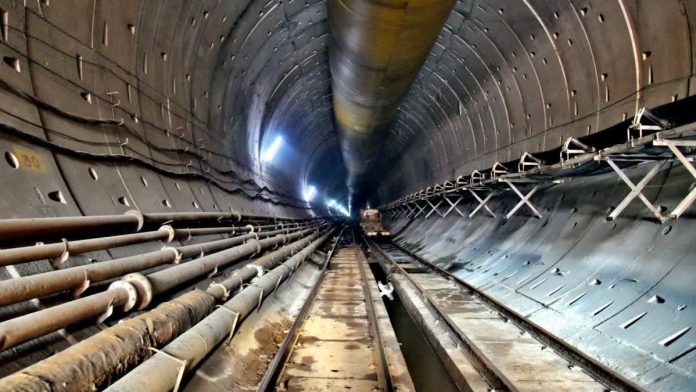Telangana Tunnel Collapse: On February 22, 2025, a tragic incident unfolded in Telangana’s Nagarkurnool district when a section of the under-construction Srisailam Left Bank Canal (SLBC) tunnel collapsed. This catastrophic event has left eight workers trapped, prompting a massive rescue operation and raising concerns about construction safety protocols.
Telangana Tunnel Collapse: The Incident
Around 8:30 AM on that fateful Saturday, approximately 60 workers were engaged in routine construction activities within the SLBC tunnel, located near Domalapenta, about 14 kilometers from the tunnel’s entrance. Without warning, a portion of the tunnel’s roof gave way, leading to a sudden influx of water and debris. While many workers managed to escape, eight individuals remained trapped inside. The victims include a project engineer, a field engineer, four laborers from Jaiprakash Associates, and two operatives from Robbins India, hailing from Uttar Pradesh, Jharkhand, Punjab, and Jammu and Kashmir.
Immediate Response
The gravity of the situation prompted swift action from both state and central authorities. Telangana’s Chief Minister, A. Revanth Reddy, expressed deep concern and directed immediate mobilization of rescue teams. Irrigation Minister N. Uttam Kumar Reddy, along with other officials, rushed to the site to oversee the operations. The National Disaster Response Force (NDRF) and the Indian Army’s Engineer Task Force (ETF) were deployed to assist in the rescue efforts. Prime Minister Narendra Modi also reached out to the Chief Minister, assuring full support and the immediate deployment of NDRF teams.
Challenges in Rescue Operations
Rescue teams have faced significant obstacles due to the tunnel’s internal conditions. The collapse resulted in extensive waterlogging and accumulation of silt, making navigation perilous. Nagarkurnool district collector B. Santhosh highlighted the absence of communication with the trapped workers, further complicating rescue efforts. The treacherous environment, characterized by thick muck and debris, has hindered the progress of heavy machinery and rescue personnel.
Statements from Officials
Minister J. Krishna Rao, after assessing the situation firsthand, conveyed the grim reality of the rescue mission. He noted that the substantial accumulation of debris and water inside the tunnel severely hampers movement, and the prospects of locating survivors appear bleak. Despite the formidable challenges, rescue teams remain committed to their mission, employing specialized equipment and strategies to navigate the hazardous conditions.
Background of the SLBC Telanagana Tunnel Collapse Project
The Srisailam Left Bank Canal (SLBC) Project, also known as the Alimineti Madhava Reddy Project, was initiated in 2007 under the erstwhile united Andhra Pradesh government. The project’s primary objective is to provide irrigation and drinking water to the Nalgonda district by channeling water from the Srisailam reservoir. Originally slated for completion in December 2010 with an estimated cost of ₹1,925 crore, the project has experienced multiple delays, escalating costs to approximately ₹4,700 crore. Notably, construction activities had resumed just four days prior to the collapse, after a prolonged hiatus.
National and State Reactions
The incident has elicited reactions from various quarters. Jharkhand Chief Minister Hemant Soren expressed concern, as four of the trapped workers hail from his state. He has been in communication with Telangana authorities, offering assistance and seeking updates on the rescue operations. The broader public and media have also been closely monitoring the situation, underscoring the need for stringent safety measures in large-scale infrastructure projects.
Safety Concerns and Future Implications
This tragic event brings to the forefront critical questions about safety protocols in large-scale infrastructure projects. The recurrence of such incidents emphasizes the necessity for rigorous safety audits, adherence to standard operating procedures, and continuous monitoring to prevent future tragedies. As rescue operations continue, there is a collective call for accountability and the implementation of enhanced safety measures to safeguard the lives of workers involved in such projects.
The SLBC tunnel collapse in Telangana stands as a somber reminder of the inherent risks associated with large-scale construction endeavors. As rescue teams persevere amidst daunting challenges, the incident underscores the imperative for unwavering commitment to safety and proactive measures to prevent similar occurrences in the future.
For more such updates follow Swadesi!




